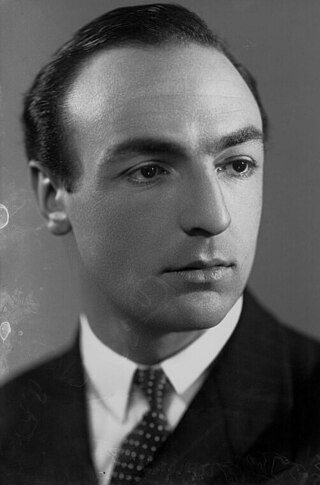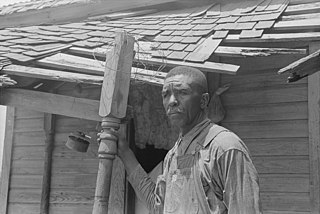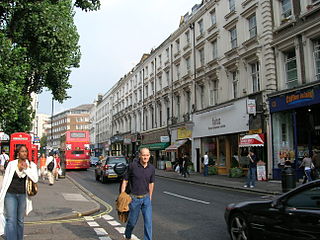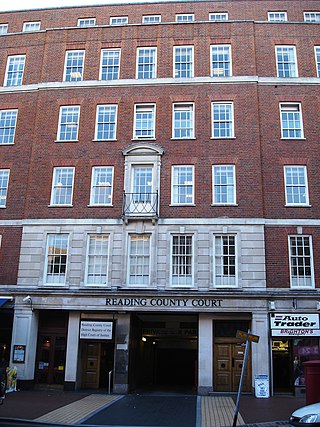
Notting Hill is a district of West London, England, in the Royal Borough of Kensington and Chelsea. Notting Hill is known for being a cosmopolitan and multicultural neighbourhood, hosting the annual Notting Hill Carnival and the Portobello Road Market. From around 1870, Notting Hill had an association with artists.

The Profumo affair was a major scandal in twentieth-century British politics. John Profumo, the 46-year-old Secretary of State for War in Harold Macmillan's Conservative government, had an extramarital affair with the 19-year-old model Christine Keeler beginning in 1961. Profumo denied the affair in a statement to the House of Commons in 1963; weeks later, a police investigation proved that he had lied. The scandal severely damaged the credibility of Macmillan's government, and Macmillan resigned as Prime Minister in October 1963, citing ill health. The fallout contributed to the Conservative government's defeat by the Labour Party in the 1964 general election.

Marilyn Foreman, better known as Mandy Rice-Davies, was a Welsh model and showgirl best known for her association with Christine Keeler and her role in the Profumo affair, which discredited the Conservative government of British Prime Minister Harold Macmillan in 1963.

A tenant farmer is a person who resides on land owned by a landlord. Tenant farming is an agricultural production system in which landowners contribute their land and often a measure of operating capital and management, while tenant farmers contribute their labor along with at times varying amounts of capital and management. Depending on the contract, tenants can make payments to the owner either of a fixed portion of the product, in cash or in a combination. The rights the tenant has over the land, the form, and measures of payment vary across systems. In some systems, the tenant could be evicted at whim ; in others, the landowner and tenant sign a contract for a fixed number of years. In most developed countries today, at least some restrictions are placed on the rights of landlords to evict tenants under normal circumstances.

A lease is a contractual arrangement calling for the user to pay the owner for the use of an asset. Property, buildings and vehicles are common assets that are leased. Industrial or business equipment are also leased. Basically a lease agreement is a contract between two parties: the lessor and the lessee. The lessor is the legal owner of the asset, while the lessee obtains the right to use the asset in return for regular rental payments. The lessee also agrees to abide by various conditions regarding their use of the property or equipment. For example, a person leasing a car may agree to the condition that the car will only be used for personal use.
A leasehold estate is an ownership of a temporary right to hold land or property in which a lessee or a tenant has rights of real property by some form of title from a lessor or landlord. Although a tenant does hold rights to real property, a leasehold estate is typically considered personal property.

Westbourne Grove is a retail road running across Notting Hill, an area of west London. Its western end is in the Royal Borough of Kensington and Chelsea and its eastern end is in the City of Westminster; it runs from Kensington Park Road in the west to Queensway in the east, crossing over Portobello Road. It contains a mixture of independent and chain retailers, and has been termed both "fashionable" and "up-and-coming".
A slumlord is a slang term for a landlord, generally an absentee landlord with more than one property, who attempts to maximize profit by minimizing spending on property maintenance, and to tenants that they can intimidate. Severe housing shortages allow slumlords to charge higher rents, and when they can get away with it, to break rental laws.
Landlord harassment is the willing creation, by a landlord or their agents, of conditions that are uncomfortable for one or more tenants in order to induce willing abandonment of a rental contract. This is illegal in many jurisdictions, either under general harassment laws or specific protections, as well as under the terms of rental contracts or tenancy agreements.

An assured tenancy is a legal category of residential tenancy to an individual in English land law. Statute affords a tenant under an assured tenancy a degree of security of tenure. A tenant under an assured tenancy may not be evicted without a reasonable ground in the Housing Act 1988 and, where periodic changes in rent are potentially subject to a challenge before a rent assessment committee.

Bruton v London and Quadrant Housing Trust[1999] UKHL 26 is an English land law case that examined the rights of a 'tenant' in a situation where the 'landlord', a charitable housing association had no authority to grant a tenancy, but in which the 'tenant' sought to enforce the duty to repair on the association implied under landlord and tenant statutes. The effect of the case is to create the relationship of de facto landlord and tenant between the parties.

Pinehurst Court is a portered Victorian mansion block at 1-9 Colville Gardens, just off Colville Terrace and near the Portobello Market in Notting Hill, London, England. The terrace was initially built in the 1870s by the builder George Frederick Tippett, as single family residences, but from the 1880s the houses began to be subdivided into flats. By 1928 the neighbourhood was described as "rapidly becoming poorer", and by 1935 as a "largely slum area". The gentrification of Notting Hill in the 1980s and 1980s greatly improved the character of the building, which now forms a part of one of London's most fashionable neighbourhoods.

Colville Gardens is a Victorian cul-de-sac street in the Royal Borough of Kensington and Chelsea, located north of Colville Terrace and east of the Portobello Market in Notting Hill, London, England. It is bordered on the north side by All Saints' Church.

Powis Square is a garden square and locality in Notting Hill, in the Royal Borough of Kensington and Chelsea in London, England. The closest London Underground station to the square is Westbourne Park tube station.
The history of rent control in England and Wales is a part of English land law concerning the development of rent regulation in England and Wales. Controlling the prices that landlords could make their tenants pay formed the main element of rent regulation, and was in place from 1915 until its abolition by the Housing Act 1988.
A section 21 notice in England and Wales also known as a section 21 notice of possession or a section 21 eviction, is the notice under the Housing Act 1988 section 21, which a landlord must give to their tenant to begin the process to take possession of a property let on an assured shorthold tenancy without providing a reason for wishing to take possession. The expiry of a section 21 notice does not bring a tenancy to its end. The tenancy would only be ended by a landlord obtaining an order for possession from a court, and then having that order executed by a County Court bailiff or High Court enforcement officer. Such an order for possession may not be made to take effect earlier than six months from the beginning of the first tenancy unless the tenancy is a demoted assured shorthold tenancy. If the court is satisfied that a landlord is entitled to possession, it must make an order for possession, for a date no later than 14 days after the making of the order unless exceptional hardship would be caused to the tenant in which case possession may be postponed to a date no later than six weeks after the making of the order. The court has no power to grant any adjournment or stay of execution from enforcement unless the tenant has a disability discrimination, public law or human rights defence, or the case is pending an appeal.
Rent control in Scotland is based upon the statutory codes relating to private sector residential tenancies. Although not strictly within the private sector, tenancies granted by housing associations, etc., are dealt with as far as is appropriate in this context. Controlling prices, along with security of tenure and oversight by an independent regulator or the courts, is a part of rent regulation.
Rent regulation in England and Wales is the part of English land law that creates rights and obligations for tenants and landlords. The main areas of regulation concern,

The Housing Act 1988 is an Act of Parliament in the United Kingdom. It governs the law between landlords and tenants. The Act introduced the concepts of assured tenancy and assured shorthold tenancy. It also facilitated the transfer of council housing to not-for-profit housing associations, which was then carried out partly through the system of Large Scale Voluntary Transfer.

Portland Road is a road in Notting Hill, in the Royal Borough of Kensington and Chelsea that was built as a speculative development in the 1850s. The road has been noted for its division into three sections of different wealth: the section between Holland Park Avenue and Clarendon Cross/Hippodrome Place being one of the most expensive places to buy a house in London, a section of terraced houses further north being also very expensive but less so than the lower reaches of the road, and a section at the northern end that was once slums and is now working class social housing and is described as being north of an "invisible line" that divides it from the privately owned sections of the road.












